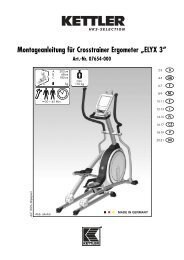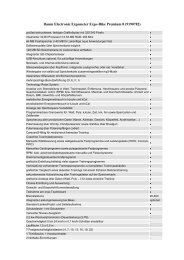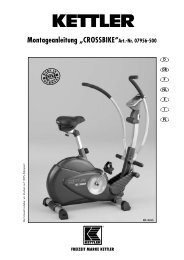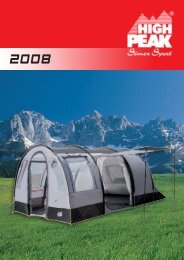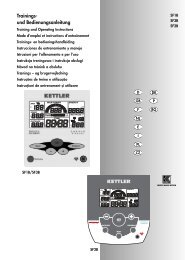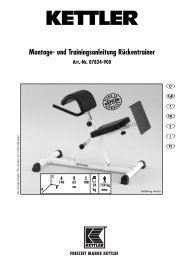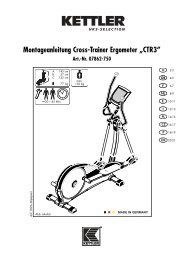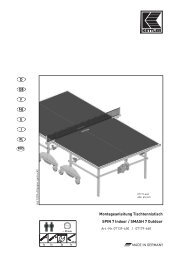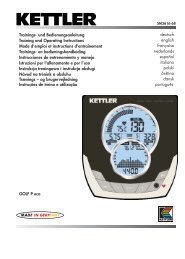RECOVERY - Sport-Thieme CH
RECOVERY - Sport-Thieme CH
RECOVERY - Sport-Thieme CH
Create successful ePaper yourself
Turn your PDF publications into a flip-book with our unique Google optimized e-Paper software.
Training and Operating Instructions<br />
performance over a longer period.<br />
3. After a certain cardiovascular performance you recover<br />
faster than before.<br />
Guide values for the stamina training<br />
Maximum pulse: maximum load means the achievement of the<br />
individual maximum pulse. The maximally achievable heart rate<br />
depends on the age.<br />
To that applies the empirical formula: the maximum heart rate<br />
per minute corresponds 220 pulse beats minus years of age.<br />
Example: age 50 years > 220 – 50 = 170 pulse/min.<br />
Weight: a further criterion for determination of the optimal training<br />
data is the weight. The nominal default for maximum load<br />
is 3 Watts/kg body weight for men and 2.5 for women. Furthermore,<br />
it must be observed, that from age 30 on capability<br />
decreases: for men approx. 1 % and for women 0.8 % per<br />
year of age.<br />
Example: man; 50 years; weight 75 kg<br />
> 220 – 50 = 170 pulse/min. maximum pulse<br />
> 3 Watts x 75 kg = 225 Watts<br />
> Minus “age discount” (20 % of 225 = 45 Watts)<br />
> 225 – 45 = 180 Watt (nominal default for maximum load)<br />
Load intensity<br />
Load pulse: the optimal load intensity is achieved at 65–75 %<br />
(comp. diagram) of the individual cardiovascular performance.<br />
This value changes depending on the age.<br />
Pulse<br />
220<br />
200<br />
180<br />
160<br />
140<br />
120<br />
100<br />
80<br />
Scope of load<br />
Duration of a training unit and its frequency per week:<br />
The optimum scope of load is given, when over a longer period<br />
65–75 % of the individual cardiovascular performance is achieved.<br />
Empirical rule:<br />
Either 10 min / training unit for daily training<br />
or approx. 30 min / training unit for 2–3 times / week<br />
or approx. 60 min / training unit for 1-2 times / week<br />
You should choose the Watts power such that you are able to<br />
stand the muscle load over a longer period.<br />
Higher powers (Watt) should be yielded in connection with an<br />
increased pedaling frequency. A too low pedaling frequency of<br />
less than 60 rpm results in a pointedly static load of the musculature<br />
and thus to early exhaustion.<br />
Warm-up<br />
Pulsediagramm<br />
Fitness and Fat Burner<br />
Maximalpulse<br />
(220 minus Age)<br />
Fitnesspulse<br />
(75% of Max.Pulse)<br />
Fat combustion pulse<br />
(65% of Max.Pulse)<br />
20 25 30 35 40 45 50 55 60 65 70 75 80 90 Age<br />
At the beginning of each ergometer training unit, you should for<br />
3-5 minutes pedal with a slowly increasing load to warm and to<br />
get your heart/circulation and your musculature moving.<br />
Cool-down<br />
The same importance has the so-called “cooling down”. After<br />
each training unit you should continue pedaling against a slight<br />
resistance for approx. 2-3 minutes.<br />
The load for your further stamina training should basically be<br />
increased over the scope of load, e.g. instead of 10 minutes<br />
your training is 20 minutes or instead of 2 times a week 3 times<br />
a week. Beside individual planning of your cardio training you<br />
can fall back on the training programs integrated in the training<br />
computer (comp. page 9 cont.).<br />
Glossary<br />
Age<br />
Entry for calculation of the maximum pulse.<br />
Dimension<br />
Units for display of km/h or mph, kjoule or kcal, hours (h) and<br />
power (Watt)<br />
Speed-independent/speed-dependent operation (running<br />
ergometer)<br />
Speed-independent operation<br />
Initially, the running ergometer always works speed-independent.<br />
Only during the training the user can select between<br />
speed-independent and speed-dependent operation with the<br />
"SET" key. If both direction arrows are displayed, speed-dependent<br />
operation is selected. Pressing the "SET" key again switches<br />
operation back to speed-independent. If the training is<br />
interrupted, the display computer automatically switches back to<br />
speed-independent operation.<br />
For speed-dependent operation, power has no upper or lower<br />
limit. If with a power of over 600 W, operation is switched<br />
back to speed-independent, the power display is set to 600 W,<br />
and the braking toque is changed respectively. If with a power<br />
display of below 25 W, operation is switched back to speedindependent,<br />
power is set to 25 W, and the braking torque is<br />
changed.<br />
Speed-dependent operation (Count Up, Count Down)<br />
Speed-dependent operation is available during training only. If<br />
there is a switchover to speed-dependent operation, the braking<br />
torque is kept constant. The displayed power is not changed,<br />
until the pedaling speed is changed. With a change in speed,<br />
the current power is calculated from the (constant) braking torque<br />
and the current pedal speed, and displayed respectively. If<br />
the power displayed in speed-independent operation is not settable<br />
(arrow symbols are shown), the actual power value is displayed<br />
in the moment of switchover. The power can be changed<br />
by means of the "+" and "-" keys or by means of speed.<br />
During training, the displayed power is increased or decreased<br />
in 5 W (or 25 W, respectively) steps with the "+" or "-" keys,<br />
respectively. For that, the current power is taken as standard.<br />
The new braking torque is calculated and set. Then the braking<br />
torque is kept constant, and the power display is calculated<br />
anew for changing pedal speed like described above.<br />
A change of the ergometer power by means of the "+" and "-"<br />
keys is only possible in the range from 25 W to 600 W. If a<br />
key outside this range is pressed, the display jumps to the next<br />
possible value within the determined limits and the braking torque<br />
is changed respectively.<br />
Energy (real.)<br />
Calculates the energy turnover of the body with an efficiency of<br />
25 % to provide the mechanical power. The remaining 75 %<br />
does the body convert to heat.<br />
32<br />
GB



